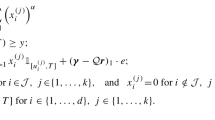Abstract
We propose a numerical method to obtain the transient and first passage time distributions of first- and second-order Multi-Regime Markov Fluid Queues (MRMFQ). The method relies on the observation that these transient measures can be computed via the stationary analysis of an auxiliary MRMFQ. This auxiliary MRMFQ is constructed from the original one, using sample path arguments, and has a larger cardinality stemming from the need to keep track of time. The conventional method to approximately model the deterministic time horizon is Erlangization. As an alternative, we propose the so-called ME-fication technique, in which a Concentrated Matrix Exponential (CME) distribution replaces the Erlang distribution for approximating deterministic time horizons. ME-fication results in much lower state-space dimensionalities for the auxiliary MRMFQ than would be with Erlangization. Numerical results are presented to validate the effectiveness of ME-fication along with the proposed numerical method.
Similar content being viewed by others
References
Ahn S, Ramaswami V (2005) Efficient algorithms for transient analysis of stochastic fluid flow models. J Appl Probab 42(2):531–549
Ahn S, Badescu AL, Ramaswami V (2007) Time dependent analysis of finite buffer fluid flows and risk models with a dividend barrier. Queueing Syst Theory Appl 55(4):207–222
Akar N, Sohraby K (2004) Infinite- and finite-buffer Markov fluid queues: a unified analysis. J Appl Probab 41(2):557–569
Aldous D, Shepp L (1987) The least variable phase type distribution is Erlang. Stoch Model 3:467–473
Anick D, Mitra D, Sondhi MM (1982) Stochastic theory of a data-handling system with multiple sources. The Bell System Technical Journal 61(8):1871–1894
Asmussen S (1995) Stationary distributions for fluid flow models with or without Brownian noise. Communications in Statistics Stochastic Models 11 (1):21–49
Asmussen S, Bladt M (1996) Renewal theory and queueing algorithms for matrix-exponential distributions. In: Alfa A, Chakravarthy S (eds) Matrix-analytic methods in stochastic models, Marcel Dekker, pp 313–341
Asmussen S, Avram F, Usabel M (2002) Erlangian approximations for finite-horizon ruin probabilities. Astin Bulletin 32(2):267–282
Bean N, Nielsen BF (2010) Quasi-birth-and-death processes with rational arrival process components. Stoch Model 26:309–334
Bladt M, Neuts MF (2003) Matrix-exponential distributions: calculus and interpretations via flows. Stoch Model 19(1):113–124
Buchholz P, Telek M (2010) Stochastic Petri nets with matrix exponentially distributed firing times. Perform Eval 67:1373–1385
Buchholz P, Telek M (2012) Rational processes related to communicating Markov processes. J Appl Probab 49:40–59
da Silva Soares A, Latouche G (2009) Fluid queues with level dependent evolution. Eur J Oper Res 196(3):1041–1048
Fackrell MW (2003) Characterization of matrix-exponential distributions. PhD thesis, The University of Adelaide
Gerber H, Shiu E (1998) On the time value of ruin. North American Actuarial Journal 2(1):48–72
He Q, Horváth G, Horváth I, Telek M (2019) Moment bounds of PH distributions with infinite or finite support based on the steepest increase property. Advances in Applied Probability (AAP) 51(1)
He QM, Zhang H (2007) On matrix exponential distributions. Adv Appl Probab 39(1):271–292
Horváth G, Telek M (2017) Matrix-analytic solution of infinite, finite and level-dependent second-order fluid models. Queueing Systems 87 (3-4):325–343
Horvath G, Van Houdt B (2012) A multi-layer fluid queue with boundary phase transitions and its application to the analysis of multi-type queues with general customer impatience. In: Proceedings - 2012 9th international conference on quantitative evaluation of systems, QEST 2012, pp 23–32. https://doi.org/10.1109/QEST.2012.12
Horváth I, Sáfár O, Telek M, Zámbó B (2016) Concentrated matrix exponential distributions. In: Fiems D, Paolieri M, Platis AN (eds) Computer performance engineering. Springer International Publishing, Cham, pp 18–31
Houdt BV, Blondia C (2005) Approximated transient queue length and waiting time distributions via steady state analysis. Stoch Model 21(2-3):725–744
Kankaya HE, Akar N (2008) Solving multi-regime feedback fluid queues. Stoch Model 24:425–450
Karandikar RL, Kulkarni VG (1995) Second-order fluid flow models: reflected Brownian motion in a random environment. Oper Res 43(1):77–88
Kulkarni VG (1997) Fluid models for single buffer systems. In: Dshalalow JH (ed) Frontiers in queuing: models and applications in science and engineering. CRC Press, pp 321–338
Le L, Aikat J, Jeffay K, Smith FD (2007) The effects of active queue management and explicit congestion notification on Web performance. IEEE/ACM Transactions On Networking 15(6):1217–1230
Mandjes M, Mitra D, Scheinhardt W (2003) Models of network access using feedback fluid queues. Queueing Syst Theory Appl 44(4):2989–3002
Neuts MF (1981) Matrix-geometric solutions in stochastic models. Johns Hopkins University Press, Baltimore
Ramaswami V, Viswanath NC (2014) Phase type distributions with finite support. Stoch Model 30(4):576–597
Ramaswami V, Woolford DG, Stanford DA (2008a) The Erlangization method for Markovian fluid flows. Ann Oper Res 160(1):215–225
Ramaswami V, Woolford DG, Stanford DA (2008b) The Erlangization method for Markovian fluid flows. Ann Oper Res 160(1):215–225
Scheinhardt W, van Foreest N, Mandjes M (2005) Continuous feedback fluid queues. Oper Res Lett 33(6):551–559
Sericola B (1998) Transient analysis of stochastic fluid models. Perform Eval 32(4):245–263
Tijms H (1994) Stochastic models: an algorithmic approach. Wiley series in probability and mathematical statistics. Wiley, New York
Velthoven JV, Houdt BV, Blondia C (2007) Simultaneous transient analysis of QBD markov chains for all initial configurations using a level based recursion. In: Fourth international conference on the quantitative evaluation of systems (QEST 2007), pp 79–90
Yazici MA, Akar N (2013) The workload-dependent MAP/PH/1 queue with infinite/finite workload capacity. Perform Eval 70(12):1047–1058
Yazici MA, Akar N (2017) The finite/infinite horizon ruin problem with multi-threshold premiums: a Markov fluid queue approach. Ann Oper Res 252(1):85–99
Author information
Authors and Affiliations
Corresponding author
Additional information
Publisher’s Note
Springer Nature remains neutral with regard to jurisdictional claims in published maps and institutional affiliations.
This work is partially supported by the OTKA K-123914 grant.
Rights and permissions
About this article
Cite this article
Akar, N., Gursoy, O., Horvath, G. et al. Transient and First Passage Time Distributions of First- and Second-order Multi-regime Markov Fluid Queues via ME-fication. Methodol Comput Appl Probab 23, 1257–1283 (2021). https://doi.org/10.1007/s11009-020-09812-y
Received:
Revised:
Accepted:
Published:
Issue Date:
DOI: https://doi.org/10.1007/s11009-020-09812-y
Keywords
- Multi-regime Markov fluid queues
- Matrix exponential distributions
- Transient distribution
- First passage time distribution




